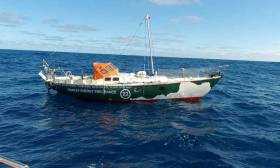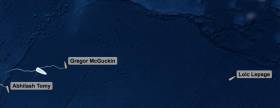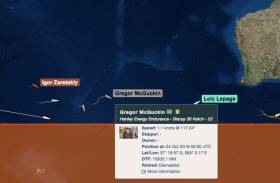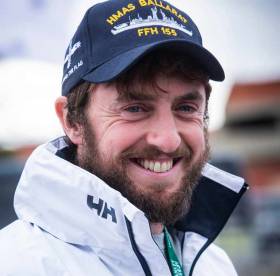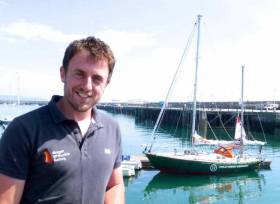Displaying items by tag: Gregor McGuckin
Round-the-World Sailing: 'You’ve Reached South Africa & You’re Nearly Home!'
Hello and welcome to my weekly Podcast …. Tom MacSweeney here ….
The Christmas and New Year festive period is a time for memories – or so it is traditionally said – and there are a few which were brought to my mind from what I have been hearing “over the Christmas….” as that beloved description goes.
Gregor McGuckin’s abandoned yacht still afloat and nearing Australia with a cargo of Irish whiskey aboard, which story has been exciting some attention since the Golden Globe Race organisers announced salvage interest in the boat – or the whiskey – reminded me of how I first came to love Jameson when crewing aboard NCB Ireland in the Whitbread Round the World Race. In the cold climes of the Labrador Banks – or thereabouts – shivering in the damp cold air on deck watch, despite all my thermal clothing – the discovery as a newcomer to that crew of a cargo of Jameson being carried aboard for some public relations purpose… and the content of one of its bottles being dispersed to those members of the crew wishing to warm up, via Irish coffee if I remember correctly - and which included me - may not have been what was intended but induced in me a love of the liquid which, over the years since has, in my view, handsomely paid off the manufacturer, irrespective of their ultimate purpose for the seaborne cargo!
And then, another memory was brought to me by two intrepid round-the-world sailors Fergus and Kay Quinlan from Kinvara recalling what it was like to arrive into a closed yacht club on Christmas morning…in Cape Town …. No wonder Fergus laughed when he was told there that – having reached South Africa, they were nearly home in Kinvara…. Only the Irish weather was waiting for them….
Listen to the podcast below
Recovery of Gregor McGuckin's Golden Globe Boat Would Be Perfect Christmas Present
Following Afloat.ie's update on Gregor McGuckin’s Biscay 36 Hanley Energy Endurance this week, Golden Globe Race organisers now say two groups have expressed interest in salvaging the yacht currently drifting some 1,200 miles West of Fremantle.
The main attraction it seems is the barrel of Glendalough 7-year-old 777 single malt Irish whiskey onboard.
The recovery of his boat would, no doubt, also make a great Christmas present for Gregor too?
Since solo sailor Gregor McGuckin of Dublin was plucked off his boat Hanley Endurance in the Indian Ocean in the Golden Globe round the world race, the dismasted 36-footer has drifted approx 580 miles in an ENE direction, and is now 1,200 miles due west of Cape Leeuwin
Gregor McGuckin's Abandoned Yacht Still Afloat, Now 1,250 Miles West of Fremantle
Gregor McGuckin's abandoned yacht Hanley Energy Endurance photographed by Golden Globe Race skipper Mark Sinclair (above) cuts a lonely sight in the South Indian Ocean.
Sinclair photographed the yacht as he sailed passed it a month after Gregor was rolled and dismasted.
Its position on 17 Dec: was Lat/Lon: 32° 28.19 S, 090° 18.88 E - 1,250 miles west of Fremantle, Western Australia
An incentive to potential salvors is a barrel of Irish Whiskey onboard that has, according to Race HQ, generated a lot of interest.
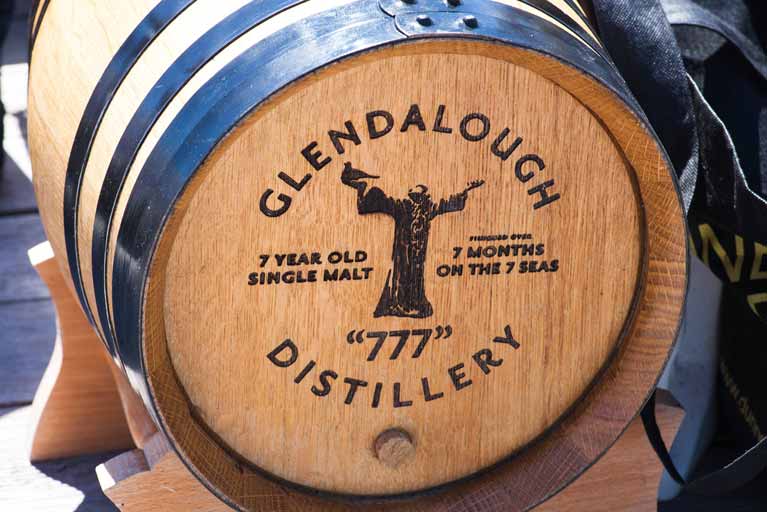 The special barrel of Glendalough 7-year-old single malt whiskey still onboard Gregor McGuckin's dismasted Biscay 36 yacht Hanley Energy Endurance left abandoned some 2.000 miles west of Fremantle, Western Australia after Irish skipper Gregor McGuckin was rescued on 23rd September. By Dec 19, the yacht had drifted to within 1,200 miles of Fremantle. The whiskey is proving an attraction to potential salvors
The special barrel of Glendalough 7-year-old single malt whiskey still onboard Gregor McGuckin's dismasted Biscay 36 yacht Hanley Energy Endurance left abandoned some 2.000 miles west of Fremantle, Western Australia after Irish skipper Gregor McGuckin was rescued on 23rd September. By Dec 19, the yacht had drifted to within 1,200 miles of Fremantle. The whiskey is proving an attraction to potential salvors
Irish Sailors, the Golden Globe & Cape Horn After 94 Years
On most coastlines in the world, you’ll invariably hear of some challenging nearby headland being referred to as “the local Cape Horn” writes W M Nixon
No other promontory worldwide has the same global image. It tells us much about the fearsome reputation of South America’s most southerly point, jutting as it does into the turbulent waters of the Great Southern Ocean where it becomes the Drake Passage, with Antarctica itself not so very far away across some of the roughest seas on the planet.
Cape Horn is always on the oceanic sailing agenda. And at the moment it is top of the list, with 73-year-old Jean-Luc van den Heede of France, leader in the Gold Globe Golden Jubilee Race, rounding it a week ago, while second-placed 41-year-old Dutchman Mark Slats (in a much-depleted fleet) will soon be there, albeit more than a thousand miles astern of van den Heede.
They and the remaining sailors in this challenging re-enactment are following in the wake of solo skipper Robin Knox-Johnston fifty years after he became the first man to sail round the world non-stop in Suhaili, with Knox-Johnston and his little ketch undoubtedly achieving one of world sailing’s truly great firsts.
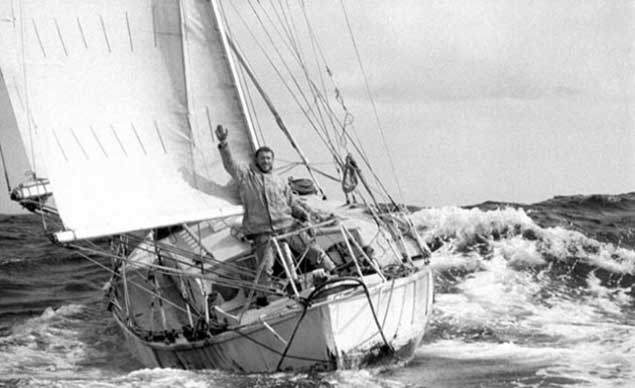 One of world sailing’s most enduring images – Robin Knox-Johnston aboard Suhaili in 1969, approaching the conclusion of his non-stop global circumnavigation
One of world sailing’s most enduring images – Robin Knox-Johnston aboard Suhaili in 1969, approaching the conclusion of his non-stop global circumnavigation
But by the time Suhaili rounded Cape Horn on 17th January 1969, a number of small sailing boats had done so before her, though none in the same epic non-stop world-girdling style. However, some 45 years had elapsed since the first rounding of Cape Horn by a small cruising boat which had crossed the southern reaches of the South Pacific to get there. But though it was hailed afterwards as the great pioneering achievement it genuinely was, at the time those involved seemed to handle it in an almost low key way, however much it may have meant to them personally.
It was the evening of Tuesday, December 2nd 1924 (94 years ago this Sunday) when the small bluff-bowed 42ft gaff-rigged Irish ketch Saoirse, a craft of antique appearance, approached Cape Horn from the west. The weather had been unsettled with winds from several directions, and two days previously, squalls from the northeast had brought flurries of snow despite it being early in the southern summer. But conditions were improving as the Horn came abeam around 2200hrs in the last of the daylight.
 Conor O’Brien’s Saoirse departing Dun Laoghaire for her global circumnavigation, June 20th 1923. She returned precisely two years later on June 20th 1925, after becoming the first small craft to run down her easting in the Great South Ocean from New Zealand to round Cape Horn. Photo: Irish Times
Conor O’Brien’s Saoirse departing Dun Laoghaire for her global circumnavigation, June 20th 1923. She returned precisely two years later on June 20th 1925, after becoming the first small craft to run down her easting in the Great South Ocean from New Zealand to round Cape Horn. Photo: Irish Times
With the onset of the short southern summer night with its brief darkness, the wind settled in the north, and the little ship made steady progress. By noon on Wednesday in fine conditions, she had made good 140 miles in 24 hours, aided by a favourable current of at least one knot. Superb visibility enabled the ketch’s crew to admire the massive scenery along the rugged coast as they shaped their course to pass eastward of Staten Island. The wind then drew fresh and favourably from the southwest, and despite progress being slowed by their vessel’s fouled bottom - for they had been at sea for more than 40 days since leaving New Zealand – by Saturday December 6th they were moored in Port Stanley in the Falkland Islands.
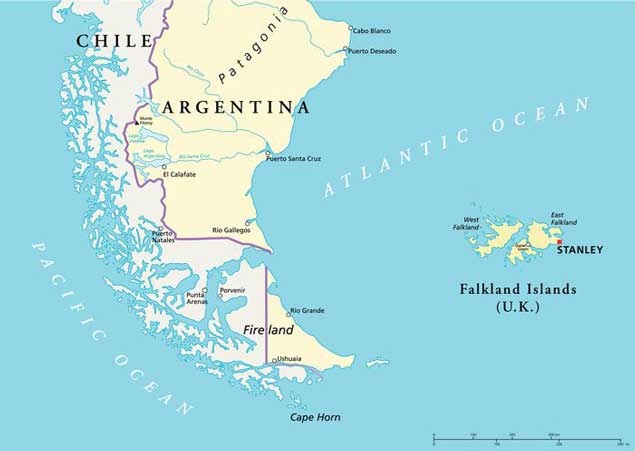 By being so far south in totally exposed waters, Cape Horn is often a huge challenge for small sailing craft
By being so far south in totally exposed waters, Cape Horn is often a huge challenge for small sailing craft
In rounding Cape Horn, the ketch’s amateur skipper Conor O’Brien (1880-1952) of Foynes Island on the Shannon Estuary had made the breakthrough towards becoming the first to take a small yacht around the world south of the Great Capes, running down his easting across the full width of the far Southern Pacific through everything that the Roaring Forties and Screaming Fifties could throw at him.
He faced it with some confidence, as his little vessel had successfully negotiated several ocean storms during her long passage from Dublin Bay. Ironically, it was in the warm and sunny latitudes of the Canary Islands that they had experienced one of their most severe tests, logging a day’s run of 185 miles while driving hard in rough seas in a sharp gale of the northeast trade winds.
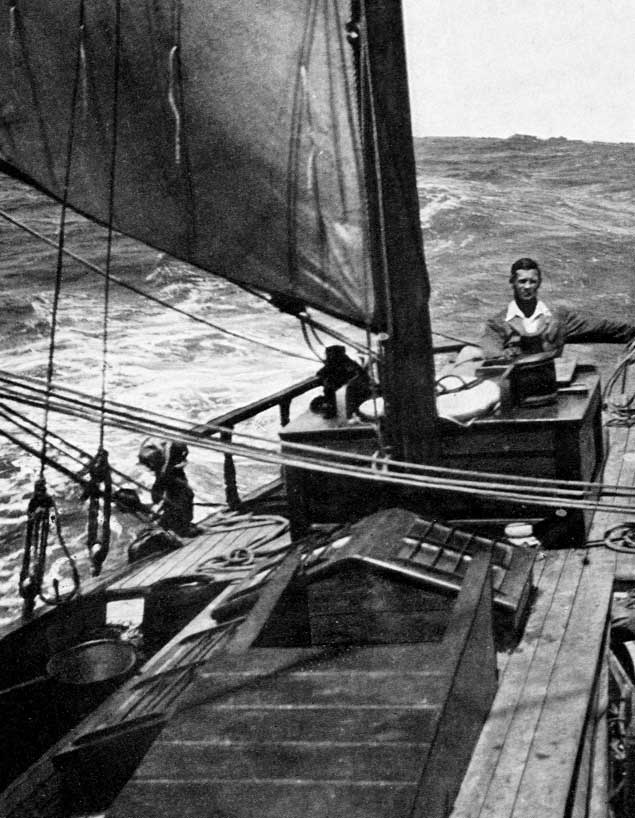 Conor O’Brien was at his most content far at sea, helming Saoirse in markedly relaxed style. Although a “bluff-bowed little vessel”, as indicated here, Saoirse was well capable of good speeds with comfort
Conor O’Brien was at his most content far at sea, helming Saoirse in markedly relaxed style. Although a “bluff-bowed little vessel”, as indicated here, Saoirse was well capable of good speeds with comfort
But O’Brien’s own-designed little ship, soundly built by Tom Moynihan and his craftsmen at the Fisheries School in Baltimore in 1922, proved well able, and continued to log many excellent 24-hours runs. The most severe conditions were experienced between southern Africa and Australia, yet the ketch seemed to lead a charmed life. Although he and his shipmates observed several huge pinnacle breakers caused by intersecting wave patterns which he felt sure would have overwhelmed his vessel had she been caught up in one of those mega-breakers, it never happened, and the long haul across the southern Pacific to curve southward to round Cape Horn was subsequently recounted in an under-stated tone. But then, that was the style of the era and the milieu from which Conor O’Brien had emerged.
O’Brien may have been rewarded with a fairly gentle rounding of the Horn itself, but the very small world of ocean voyagers at the time had no doubt of the quality of his achievement. Although Joshua Slocum in Spray had negotiated his way westward from the Atlantic to the Pacific through the channels north of Cape Horn some 28 years earlier, the weather he’d experienced, coupled with the historical stories from the crews of much larger sailing ships which had succeeded in rounding the Horn – for many failed in the attempt – left no doubt about the extremely changeable and often ferocious conditions which were central to the challenge O’Brien had faced.
 Conor O’Brien designed Saoirse himself, and while she was basically of old-fashioned style, she was way ahead of most boats of the time in having the galley well after in the area of least motion
Conor O’Brien designed Saoirse himself, and while she was basically of old-fashioned style, she was way ahead of most boats of the time in having the galley well after in the area of least motion
For circumnavigator sailors from Europe, once you’ve rounded Cape Horn and returned to Atlantic waters, there’s a reassuring feeling of being on the home stretch, for all that there are ten thousand miles still to sail. Certainly O’Brien and his crew of two became so relaxed that they spent six weeks in the Falklands over the Christmas period, becoming so much part of the local community that a crew-member married a local girl and much of Saoirse’s subsequent voyage northward through the Atlantic was made with just two on board.
Yet although it all continued to be done in a low key style, O’Brien was no slouch when publicity opportunities arose, and he returned to Dun Laoghaire on Saturday June 20th 1925 – two years to the day since he departed – in order to facilitate a rapturous welcome. Dublin Bay Sailing Club even cancelled their Saturday racing programme so that their members could join the fleet welcoming Saoirse home.
For most of the voyage, however, Saoirse and her crew were totally out of contact, and could get on with traversing the oceans in traditional lone ship style. And 45 years later, there were long periods in 1968-69 when Robin Knox-Johnston’s location with Suhaili was a matter of speculation rather than precision – it was something of a surprise when the battered but unbowed little ketch appeared in the distant approaches to Falmouth to claim an indisputable “first”.
But today, a constant flow of information in every shape and form is central to any major oceanic sailing event. The Golden Jubilee of the Golden Globe is supposed to be a retro event in which the participants sail old-style boats of closed hull profile using only the technology available in 1968. But the demands of the 21st century with its multiple communication technologies means that the outside world knows almost everything that is going on in this nine month saga.
Thus when Jean-Luc van den Heede had passed Cape Horn a week ago, it so happened that the AGM of the Old Cape Horners Association was being held in England’s historic naval harbour of Portsmouth, and they were provided with a radio linkup with the 73-year-old Frenchman who revealed that it was in fact his tenth rounding of the Horn, and his most recent visit had been during a cruise in the area when they’d landed at Cape Horn island’s semi-sheltered bay, and had gone visiting with the lighthouse keepers for all the world like cruisers of yore making their way along the west coast of Ireland or through the Hebrides.
 Image of a great seaman – the 73-year-old Jean-Luc van den Heede. He has completed his tenth rounding of Cape Horn, leading the Golden Globe Golden Jubilee Race. On his ninth rounding, he was cruising, and he and his crew went ashore and visited the lighthouse keepersThis almost light-hearted approach to the realities of Cape Horn is classic van den Heede, for in order to still be in the lead in the Golden Globe, he had to survive a knockdown four weeks ago which was so violent that it caused the through-mast bolt supporting his lower shrouds to cut its way downwards through the mast extrusion, leaving the vital lower shrouds dangerously slack.
Image of a great seaman – the 73-year-old Jean-Luc van den Heede. He has completed his tenth rounding of Cape Horn, leading the Golden Globe Golden Jubilee Race. On his ninth rounding, he was cruising, and he and his crew went ashore and visited the lighthouse keepersThis almost light-hearted approach to the realities of Cape Horn is classic van den Heede, for in order to still be in the lead in the Golden Globe, he had to survive a knockdown four weeks ago which was so violent that it caused the through-mast bolt supporting his lower shrouds to cut its way downwards through the mast extrusion, leaving the vital lower shrouds dangerously slack.
For a while it looked as though he’d have to divert to Chile for repairs, but somehow this doughty veteran got aloft and cobbled together a repair which held together has now got him round Cape Horn and on to what is admittedly the longest homeward stretch in the world. But his performance is impaired, and he usually has three reefs in the main when only two would be needed were all the rig in full health.
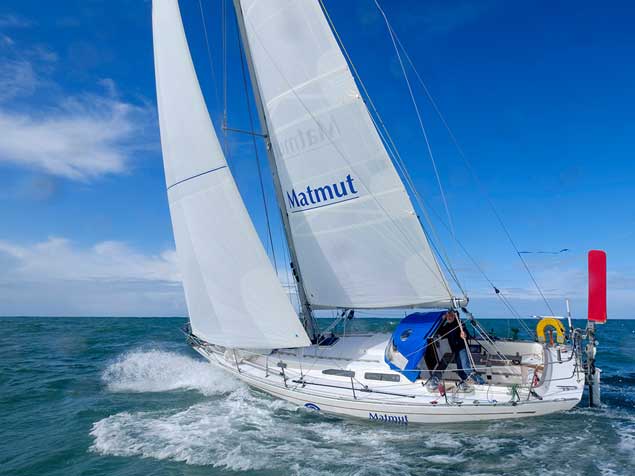 Van den Heede’s Rustler 36 Malmut before the race – the problematic through-mast bolt and tang for the lower shrouds is visible below the lower spreaders
Van den Heede’s Rustler 36 Malmut before the race – the problematic through-mast bolt and tang for the lower shrouds is visible below the lower spreaders
This has meant that second-placed Mark Slats of The Netherlands has been closing the gap, but as van den Heede was an astonishing 1470 miles ahead when his rig damage occurred, Slats has to steadily outperform him by 20% in order to be first back to les Sables d’Olonne in 2019, and since van den Heede got into the Atlantic, the Slats rate of gain has slowed.
Race Tracker here
Both van den Heede and Slats are racing Rustler 36s, a slippy Holman & Pye designed sloop of 1980 which fits neatly into the retro requirement of being a 36ft production design of 1980 or earlier with the specified closed profile, even if in the Rustler 36’s case it does result in a transom stern with a very steeply sloping rudder and a propeller in a large aperture cut from the rudder, which must make them the very devil to handle under power in astern, or indeed under power in any confined manoeuvring situation under power, where prop thrust is often the key to doing the job.
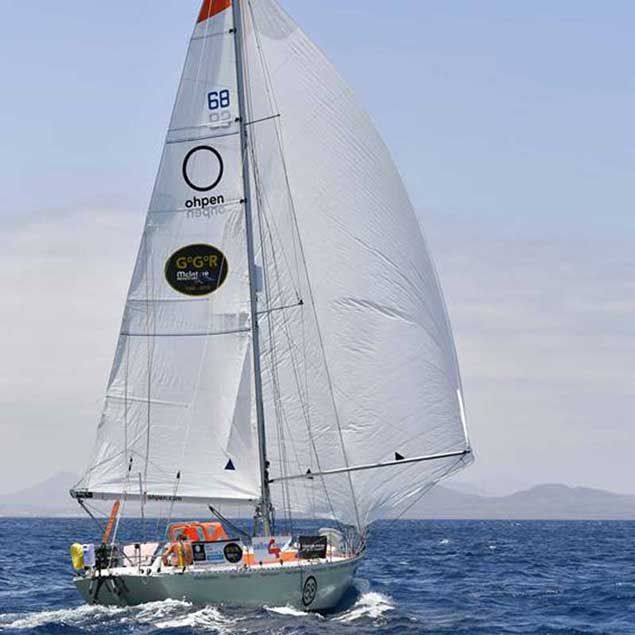 Mark Slats’ Rustler 36 Ohpen Maverick with the steeply-raked ransom and sloping rudder much in evidence
Mark Slats’ Rustler 36 Ohpen Maverick with the steeply-raked ransom and sloping rudder much in evidence
This is probably not remotely of interest in the Great Southern ocean, but as Tim Goodbody so brilliantly revealed with his J/109 in Dublin Bay last weekend, a boat which has an easily-accessed stern-boarding system and handles confidently in astern under power is a very effective rescue machine in a man-overboard situation.
But that’s another topic to which we’ll return some day. Meanwhile, the reality was that the most popular design which turned up to start the Golden Globe Golden Jubilee was the Rustler 36, something of a surprise to casual observers as most folk had initially thought the response would be something nearer Suhaili, and ketch-rigged too.
But as it happens, the one Suhaili sister-ship which was allowed in under special dispensation, Abilash Tomy’s Thuriya from India, and one of the few other ketch-rigged boats, our own Gregor McGuckin’s Biscay 36 Hanley Energy Endurance, were both dismasted in September in the mother of all storms in the middle of the southern Indian Ocean.
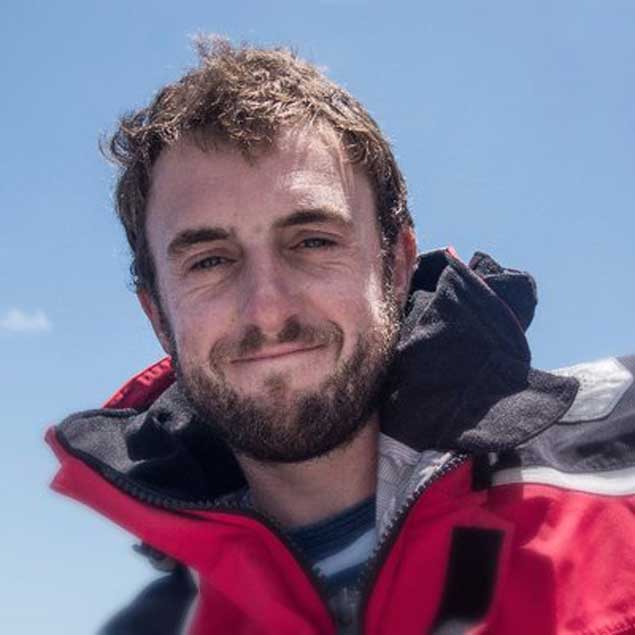 Gregor McGuckin – he was dismasted after being rolled 360-degrees in an exceptional storm in an area of the Southern Indian Ocean where Conor O’Brien had noted the power of multi-directional cross seas to build freak waves
Gregor McGuckin – he was dismasted after being rolled 360-degrees in an exceptional storm in an area of the Southern Indian Ocean where Conor O’Brien had noted the power of multi-directional cross seas to build freak waves
Their skippers were successfully retrieved by a French Fisheries Patrol vessel while McGuckin was in the midst of an heroic effort to get to the seriously-injured Tomy under jury rig. But despite promises that Thuriya would be retrieved by the Indian Navy and restored to seagoing standard, she still seems to be out there and virtually not moving at all. This suggests that she is still lying to her broken rigging, whereas McGuckin’s boat is now nearly 400 miles away nearer Australia, as before his controlled retrieval and passage towards Tomy under jury rig, he succeeded in cutting adrift all the broken spars and rigging, and the former ketch has sometimes been drifting at 1 knot and more.
The experience of McGuckin and Abilash in that “perfect storm” is of added interest in that it happened in the area of ocean where Conor O’Brien saw his ultimate breaking crest. The wind strengths were nothing like the horrific power which assaulted Tomy and McGuckin, as at the time Saoirse was running in her surprisingly speedy style before “a moderate gale” (as they used to say), and O’Brien and his helmsman observed a large waving moving along with them maybe about a mile away.
There were marked cross seas running at the time – a significant factor recorded by Gregor McGuckin – and they went to work on this big wave until it peaked out like the Matterhorn or Mount Fuji, an absolutely extraordinary pinnacle of water which then collapsed in hundreds of thousands of tons of breakers and spume.
Neither O’Brien nor his shipmate said a word to each as this all-powerful force of nature manifested itself, but afterwards in his deck log he noted that had Saoirse been caught up in it, she and her crew would have instantly been goners. As for the professional seaman who’d been helmsman at the time, as soon as they reached port in Australia, he went ashore and wasn’t seen again. It greatly annoyed O’Brien, as this was the only helmsman other than O’Brien himself who had shown he could get Saoirse to perform to her best, and O’Brien had hoped that in due course the situation would arise where their combined efforts would see Saoirse achieve the 200 miles day’s run of which he was convinced she was capable.
 Conor O’Brien as portrayed by his wife, the artist Kitty Clausen
Conor O’Brien as portrayed by his wife, the artist Kitty Clausen
He had many crew changes, but despite that and other difficulties, his underlying intention to sail home via Cape Horn was maintained. Ninety-four years ago on Sunday, it was achieved - a simple and beautiful historical fact of small craft ocean voyaging.
Today, the realities of the Golden Globe Golden Jubilee race underline the remarkable nature of what Conor O’Brien and Saoirse made into reality. He may not have been single-handed, but his crew of two were of limited experience, the boat was of extremely primitive type by today’s standards, and the elements of the unknown in what they were undertaking were beyond calculation.
Now that we know so much more about Cape Horn and the conditions which may be experienced in sailing past it, O’Brien’s feat with Saoirse in 1924 becomes that much greater. He may have died on Foynes Island in 1952, but Saoirse has lived on, and she is currently being re-built by Liam Hegarty at his Oldcourt Boatyard near her birthplace of Baltimore. In 2020, Saoirse will sail again, and we will wonder anew at the achievement of the great pioneering sailor of Limerick.
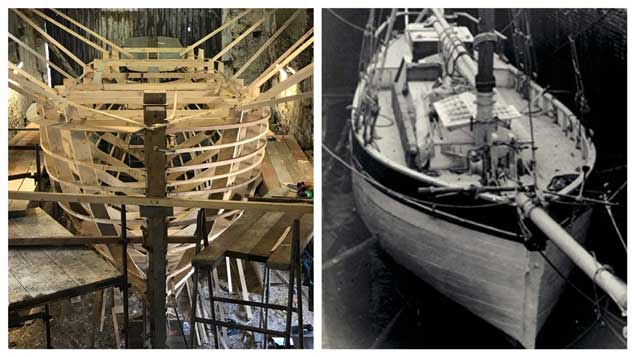 Saoirse being re-built in Oldcourt (left) and as she was in the 1930s after her global circumnavigation of 1923-25. Photos Gary MacMahon
Saoirse being re-built in Oldcourt (left) and as she was in the 1930s after her global circumnavigation of 1923-25. Photos Gary MacMahon
Australian Sailor to Report on Gregor McGuckin's Abandoned Yacht in the Indian Ocean
As Afloat.ie reported five days ago, Gregor McGuckin's Round the World Yacht is still drifting a month after evacuation in the Golden Globe Race. The Dubliner's yacht is not the only Golden Globe boat left adrift, and here's an update on what has happened to the yachts abandoned in the Indian Ocean.
Frenchman Loïc Lepage cut one of the inlet pipes to scuttle his dismasted Nicholson 32 Laaland before he abandoning her for the safety of the Japanese bulk carrier Shiosai on October 22 and the yacht’s tracking signal stopped within a few hours signalling that she had sunk
But Abhilash Tomy’s Thuriya and Hanley Energy Endurance skippered by Gregor McGuckin, both abandoned some 45 miles south of an International Marine Reserve surrounding the Amsterdam and St Paul chain of Islands on September 23 were left afloat. The battery running Thuriya’s tracker ran out of power on October 3, but that on Hanley Energy is still pinging away on the GGR tracker.
What state is she in? Could she be salvaged? Australian Mark Sinclair trailing in 7th place aboard his Lello 34 Coconut passed close to Amsterdam Island last Friday and is now within 180 miles of the Irish yacht. He has agreed to try and intercept her position during the next two days, photograph her and report back on her condition.
It's just over a month since Gregor McGuckin was forced to 'evacuate' his dismasted Biscay 36, 'Hanley Energy Endurance', and so ending his solo attempt at a non-stop circumnavigation in the Golden Globe Race.
As Afloat.ie readers know, McGuckin is now safely back home on dry land, but what has happened to the abandoned yacht? Well, latest tracking information suggests that it is drifting at a rate of about 1 knot in an ENE direction. At this rate, the earliest landfall would be no sooner than two months away. The drift direction is towards north-west Australia, but the current regime in the Indian Ocean suggests that before it makes landfall it could be carried northwards initially and then westwards. Indeed, if not salvaged or sunk, it might never make landfall as the prevailing currents combine to create an anti-clockwise flow around the Indian Ocean.
While an unmanned, drifting vessel is clearly a hazard to other vessels, this part of the ocean is sparsely populated.
The Golden Globe race tracker continues to display 'Hanley Energy Endurance’s' current position, here, but it is not certain how this is powered and how long it can be maintained. With no power, and a low radar profile, the yacht becomes harder to detect and will be a danger, particularly at night time, so it will be interesting to learn of salvage plans if any?
Irish Solo Sailor Gregor McGuckin Returns Home to a Hero’s Welcome
Heroic Irish solo sailor Gregor McGuckin arrived back in Dublin today to a rapturous welcome in Dublin Airport from his family, friends and members of the sailing community.
It is Gregor’s first time on Irish soil since embarking on his attempt to be the first Irishman to sail around the world solo non-stop. He was competing in the Golden Globe Race, which is known as the ‘Mount Everest of sailing races’.
During this morning's Press Conference at Dublin Airport, the solo sailor described the circumstances leading up to his evacuation:
"We heard about the storm coming a day or two beforehand but every update was different so it was quite hard to plan for.
I headed north and we were in the worst possible place to be in at the worst possible time. I was right in the convergence zone were cold and warm water meets and everything passing through gets condensed.
By 6pm the wind was gale force and at midnight the boat got knocked down for the first time. I was quite surprised to lose mizen mast because the storm didn’t seem that bad. It was far from meaning the end of the race though and I went into survival mode - the worry was the bow of the boat would pitchpole so I set out trailing lines.
The biggest problem was to keep her downwind. It was quite challenging by steering by hand in those conditions and I did feel quite exposed. The waves were over 10 metres, some 15, and the sea was just white. It was amazing looking it - I was pinned by the wind, I could barely move arms.
I eventually got the self-steering set up and went below deck. I was checking the sea state and saw this big wave coming - I stuck my head out and it just broke on the starboard quarter. The swell was coming from a northerly direction and the south, its was really messy and created this huge mountain which threw me sideways. The boat is 10ton and being thrown up like that takes a phenomenal force.
I could see orange sail by the side so cut it away as soon as possible with a bolt cutter and hacksaw. It destroyed my hands. I just got below again when we got knocked over again.
The storm lasted six hours. I knew my race was over so wedged myself in a safe place. I was pretty depressed and was going to sleep it through, but then I heard about Abhilash being disabled from race control.
I put together jury rig and made a course for him. Then the wind dropped which was really frustrating. I had to wait until another gale came along before I could start making 5-6 knots. I was getting very mixed information all this time, I knew an Australian warship and French fisheries vessel were on their way but I thought I might be the first on scene - I was praying I wouldn’t be.
Then I heard that they had evacuated him, and I requested evacuation too. I had limited means to sail and the worry was that if I tried to make shore potentially I’d have to call another rescue mission, which would be a bit reckless. We were brought to Amsterdam Island, where a research team looked after us. I’ve been chatting to Abhilash since - he fractured vertebrae and has had surgery.
The people suffering most were people at home - they didn’t know what was going on, whereas as we were in the middle of it. It was quite a harrowing time for my girlfriend and family.
I’ll have to get back on my feet before consider going back".
Gregor captured the world’s attention when his yacht, the Hanley Energy Endurance, was rolled over twice and dismasted during an enormous storm in the treacherous seas of the South Indian Ocean. His fellow competitor in the race, an Indian naval commander named Abhilash Tomy, who was also capsized and dismasted in the storm, suffered a very serious back injury and was unable to move or steer his yacht.
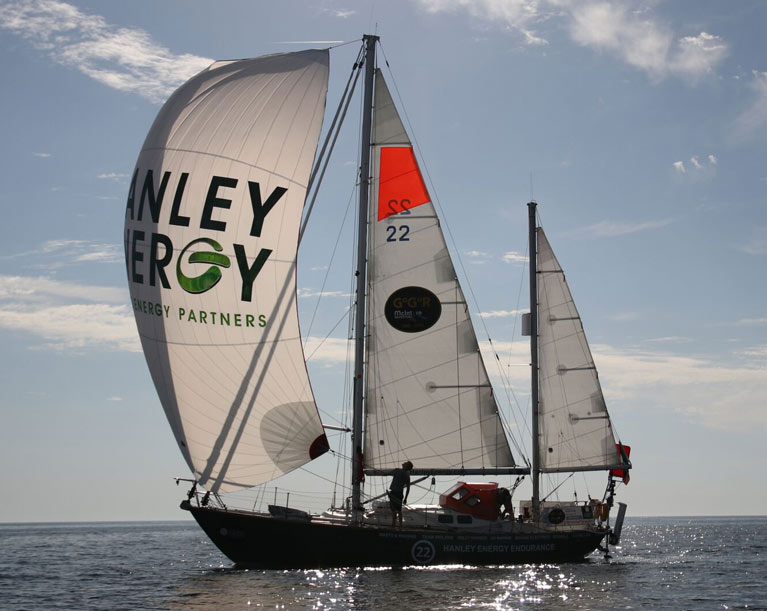 Gregor McGuckin under full sail on board his ill–fated Golden Globe Race boat prior to her dismasting
Gregor McGuckin under full sail on board his ill–fated Golden Globe Race boat prior to her dismasting
In a truly remarkable feat of seamanship and heroism which inspired and amazed the sailing world, Gregor ‘jury-rigged’ a small mast and sail on his yacht and battled the storm for a brutal four days and nights to get close to Tomy and attempt a rescue.
A French fisheries patrol vessel, the FPV Osiris managed to get to Tomy before McGuckin did. The vessel then sailed to evacuate Gregor from his yacht to prevent the need for a second rescue mission. McGuckin and Tomy were treated at the medical centre on Ile Amsterdam (Amsterdam Island) in the southern Indian Ocean. The Australian naval vessel HMAS Ballarat collected McGuckin to take him to Perth in Western Australia.
At a press conference in Dublin Airport hosted by Gregor and his headline sponsor Hanley Energy, Gregor gave a flavour of the hardships he endured; ‘’when I heard that Abhilash was in serious trouble I knew immediately that I had to do what I could. With the jury-rig on the Hanley Energy Endurance, I was only able to hand steer, which meant I had to be on deck in order to make any progress towards Abhilash. The weather conditions at this point were still appalling.’’
Gregor was warmly welcomed by his sponsor, Hanley Energy. Speaking at the press conference today, Hanley Energy Managing Director Dennis Nordon said; ‘’we are absolutely thrilled to have Gregor home safely. All of us here are indescribably proud of his bravery in unimaginably tough circumstances, and we are looking forward to continuing to support his endeavours.’’
Gregor has spent the past two weeks recovering in Perth in Australia where he was brought by the Australian Navy following medical treatment on Amsterdam Island in the Indian Ocean.
Being dismasted during a shattering 360 degree roll in the tumultuous Southern Indian Ocean in the roughest part of the Golden Jubilee Golden Globe Race would have created an extreme survival situation for most sailors. But after it happened to Gregor McGuckin with his vintage Biscay 36 ketch Hanley Energy Endurance, he soon heard that, 90 miles away, rival skipper Abilash Tomy was in an even worse situation, dismasted and incapacitated by injury.
McGuckin immediately set about clearing his vessel and erecting a jury rig, as at that time he appeared to be the only vessel near enough to bring help in time to Tomy. He had got to within 30 miles of the crippled boat when help arrived earlier than expected through an Arctic Fisheries Patrol vessel, but Gregor McGuckin’s selfless heroism is deserving of the highest praise.
Gregor McGuckin’s Path to Fame Underlines Ireland’s Challenges in Finding a Place in Offshore Sailing
Gregor McGuckin is currently and very deservedly the best-known Irish sailor in the world writes W M Nixon. The sheer gallantry and utter rightness of his efforts to bring aid last weekend to injured fellow Golden Globe competitor Abilash Tomy of India – despite his own boat being dismasted – amounted to selfless heroics of the highest order.
In a weekend in which confused messages were emerging from the incidents in one of the remotest parts of the Great Southern Ocean to the south of the Indian Ocean, the golden thread of the storyline of Gregor McGuckin’s battle to get to Tomy with his jury-rigged 36ft Hanley Energy Endurance gradually emerged as a constant theme.
In the end, as larger organisations were getting to grips with the special problems of a distant rescue, it was France’s workaday fisheries patrol vessel Osiris which emerged relatively unheralded on the scene, successfully carrying out the rescue of Tomy from his mastless ketch Thuriya, and the controlled evacuation of the Irish skipper from his disabled boat in this especially hostile area of ocean more than 1800 miles from Australia.
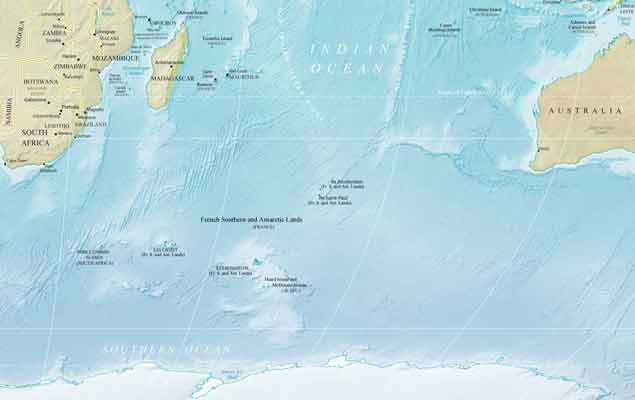 The incidents occurred at the centre of this map. Although there were small islands in the area, the nearest ports were 1800 miles away.
The incidents occurred at the centre of this map. Although there were small islands in the area, the nearest ports were 1800 miles away.
The rugged, harsh and sometimes secretive world of the global operation of fisheries is very different from the adventure-oriented ethos of the Golden Globe Race, and the high-profile formally-structured approach of top officialdom in undertaking such an operation, notably by the Royal Australian Navy and the Indian Navy - Abilash Tomy is an Indian Naval Commander.
For the crew of Osiris – who must have one of the toughest yet most unglamorous jobs in the world – it was all in a day’s work. But for a waiting world which had been fed on stories of how an aerial rescue might be undertaken and how long it would take an Australian naval vessel to reach the scene, it seemed little short of a miracle, and it was only on Sunday morning on Afloat.ie that we were able to confirm that a French fisheries patrol vessel had become the best hope of a timely rescue for Tomy, whose serious back injury meant he had been unable to access fresh water since his 360 degree rolling and dismasting on Friday.
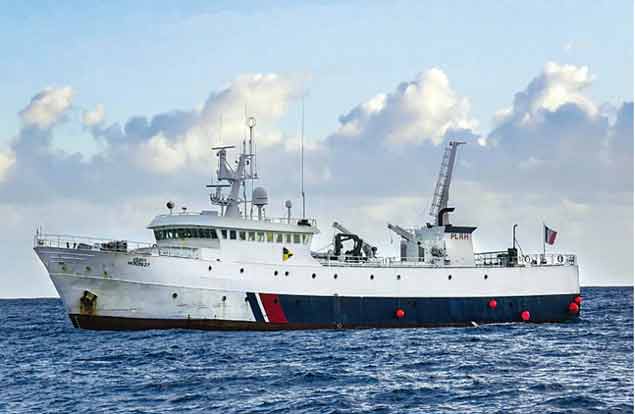 The unglamorous heroine of the tale – the French Fisheries Patrol vessel Osiris. She herself is a ship with quite a history - it may have included piracy. And she was confiscated as an illegally fishing African vessel in French territory, with the new owners making the practical decision to use her for their own fisheries patrols in a decidedly rugged part of the ocean.
The unglamorous heroine of the tale – the French Fisheries Patrol vessel Osiris. She herself is a ship with quite a history - it may have included piracy. And she was confiscated as an illegally fishing African vessel in French territory, with the new owners making the practical decision to use her for their own fisheries patrols in a decidedly rugged part of the ocean.
By Saturday, Greg McGuckin had cleared away most of the wreckage of his main rig and had somehow - despite sea conditions which were still appalling although the wind had eased – erected the jury rig and begun the painfully slow 90 miles to Tomy’s boat Thuriya with some help from his auxiliary engine. But this was not running at full power, as the fuel has become contaminated with sea water which had entered through the fuel tank breathers during the total capsize.
This meant that McGregor was acutely aware that his access to effective engine use might be just for a very limited period. After that, any further progress would be by jury rig only. Thus when the situation was transformed by the arrival of Osiris after McGregor had been hand-steering his slow-moving boat for nearly four days as all auto-steering was disabled, he personally was facing the stark choice of taking the opportunity of a controlled evacuation from his own vessel when it was still available, or hanging on and risking the need of another rescue operation when his struggling boat was further damaged in the next big storm.
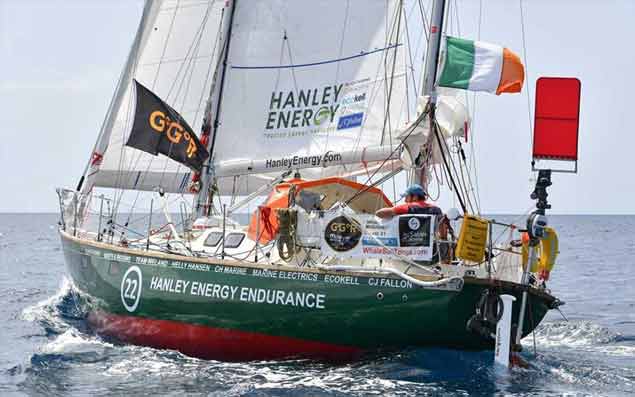 Gregor McGuckin at the start of the Golden Globe, Sunday 1st July with the 1970s Biscay 36 production cruiser Hanley Energy Endurance transformed into a serious ocean-going proposition
Gregor McGuckin at the start of the Golden Globe, Sunday 1st July with the 1970s Biscay 36 production cruiser Hanley Energy Endurance transformed into a serious ocean-going proposition
 Gregor’s boat as she’d become on September 22nd, battered but unbowed, reduced to jury rig but making progress.
Gregor’s boat as she’d become on September 22nd, battered but unbowed, reduced to jury rig but making progress.
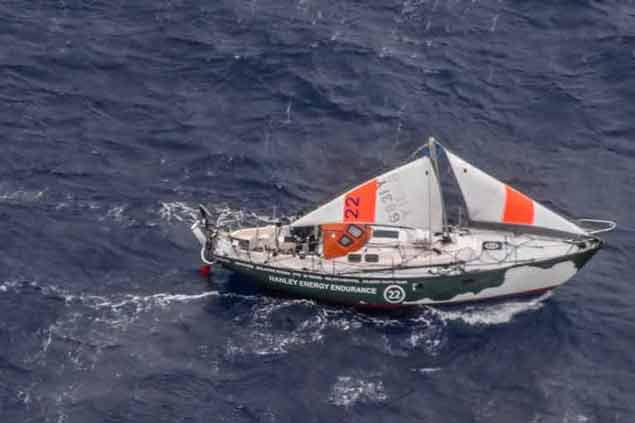 It took great feats of seamanship, courage and endurance to clear the boat’s original broken rig and erect this emergency rig in its place
It took great feats of seamanship, courage and endurance to clear the boat’s original broken rig and erect this emergency rig in its place
The decision he took to request a controlled evacuation was absolutely the right one, though inevitably a painful one too. But the fact that he’d had to do something as quietly heroic as sailing his crippled boat towards Tomy to achieve the supportive recognition he has received is a reminder, were it needed, of how any aspiring international offshore sailor in Ireland seems to have to make at least twice the effort of anyone from any other country in order to get a foothold on the steps of the big-time pathway.
There’s no denying we’re an island with immediate access to offshore racing waters of the most demanding international quality. But ultimately, promoting professional offshore racing is all about population density and national wealth, and the kind of marketing which is always seeking new outlets to remind people of existing products and services, or to introduce new ones.
In Ireland, we’ve a small population and few big companies. And maybe because we have an excess of sea, people tend to look to the land for their sport.
But in France, with its enormous land area, large population in a corporate society, highly-organised social infrastructure, great underlying wealth, and relatively limited direct acquaintance with the sea which thereby makes it an altogether more exotic element, the professional offshore racing setup is much more highly developed. This is shown by the upcoming entry for the Transatlantic Route de Rhum to Guadeloupe in the Caribbean, which starts at St Malo on November 4th – 127 boats are confirmed, all of them receiving international attention, and not an Irish one among them despite it being a known indicator for the Big One, the Vendee Globe in 2020.
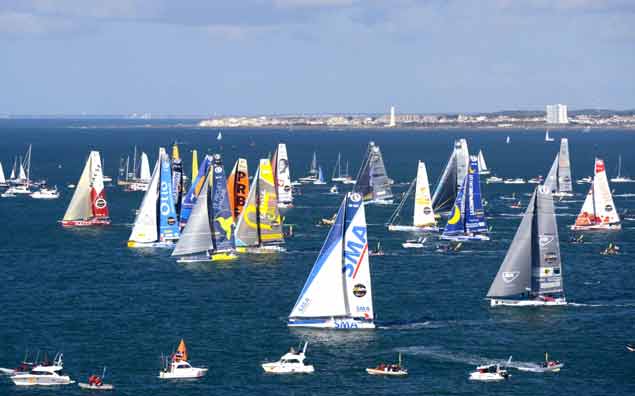 The ultimate challenge. The IMOCA 60 class starting the non-stop round the world Vendee Globe race from Les Sables d’Olonne
The ultimate challenge. The IMOCA 60 class starting the non-stop round the world Vendee Globe race from Les Sables d’Olonne
Yet the development of this quietly confident French sailing pre-eminence, which has been operating for years at many levels with, for instance, French boats winning overall in the last three Rolex Fastnet Races, has been no happy accident. Arguably, it stems from the Glenans Sailing Schools, which began in Brittany in 1947 as a deliberate move to encourage France’s young people into sailing as part of a programme to revive a demoralized country after World War II.
Sailing superstars such as Eric Tabarly emerged as heroes for this new interest in sailing, and over the decades a much more positive attitude to the sea and sailing in all its forms has resulted in 21st Century France being arguably the world’s sailing superpower in terms of the level of national involvement – every French schoolchild gets a minimum of a week of learning to sail every year – and the range of the sailing involved. There are many more major – and inevitably highly-sponsored - international offshore events from France than from any other country.
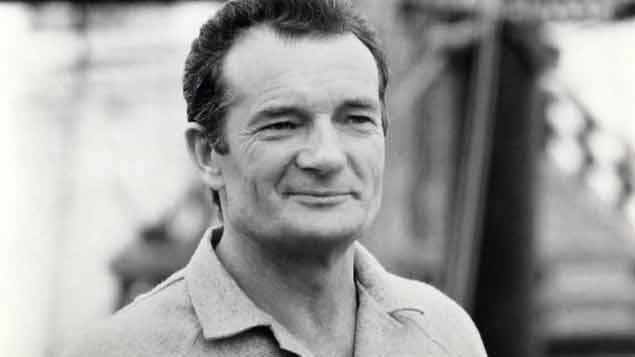 The pioneer. The memory of Eric Tabarly continues to be the great inspiration for French sailing development
The pioneer. The memory of Eric Tabarly continues to be the great inspiration for French sailing development
Within their own cohesive nation, they have the population, the level of economic activity and resources, and the official support to operate at this level. Ultimately, it’s the numbers game – population levels and concentrations of spending power need to be high to support such levels. Looking perhaps wistfully from small, under-developed Ireland, an Ireland where mounting any major sailing campaign has to overcome many hurdles which have been long since been dealt with on the Continent, we have only to remember that in another national example, the Dutch Olympic Sailing Team operates on a basic annual budget of €18 million, and their current rates of medal success reflect this.
 The traditional image of Dutch sailing. They keep their classic vessels in superb order – yet they also fund their Olympic Sailing Team with a basic €18 million annual grant
The traditional image of Dutch sailing. They keep their classic vessels in superb order – yet they also fund their Olympic Sailing Team with a basic €18 million annual grant
Thus the French dominance is not total – many European nations have well-structured sailing development programmes – but it is France’s range of major events which is the unrivalled attraction for young offshore sailors keen to make their mark. And even in an event which theoretically should have been British through-and-through – the Golden Jubilee of the Golden Globe Non-Stop Round the World race of 1968-69 – it was France which stepped into the organisational breach through the keenly self-promoting port of Les Sables d’Olonne, ready and willing to take on the mantle of staging the challenge.
For Ireland’s Gregor McGuckin, an adventure sailor who has in recent years made his living in the sometimes humdrum world of many Transatlantic deliveries and in skippering a large charter yacht in the Caribbean, the Golden Globe was the Golden Opportunity to step up the ladder and show his true potential. Its re-enactment rules, which insisted on closed profile hull designs of boats designed no later than 1980, indicated a manageable budget even within the stringent security and safety requirements.
Yet in the Ireland of 2016-17-18, when McGregor was putting his campaign together, there were many other demands on the very limited national spend on promotion through sailing spectaculars. But a boost of support from Hanley Energy got McGuckin and his greatly-strengthened 1975-vintage Biscay 36 to the line at Les Sables-d’OLonne on July 1st, and the rest we know – he was battling with Tomy for third place when the Storm of Storms struck them, and in an area notorious for its stupendous pinnacle waves, both boats were taken out by 360 degree rolls with the almost inevitable dismasting, and Tomy was injured.
It speaks volumes for the high standards of safety and seaworthiness set by the organisers that now – with no less than three boats exiting the race in this violent way – all three boats have survived, with the first to go – Norway’s Are Wig – reaching Cape Town under jury rig without assistance.
As for Greg McGuckin’s Hanley Energy Endurance, she has been battened down in mid-ocean while her skipper was taken by the Osiris to remote Amsterdam Island for collection by the Royal Australian Navy’s HMAS Ballarat for onward transit to Perth, where he will arrive early next week.
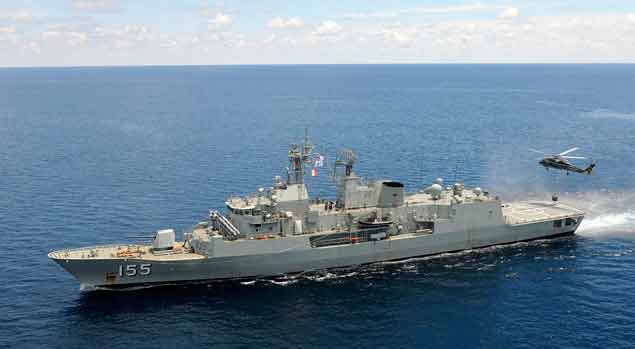 HMAS Ballarat – Gregor McGuckin is now safely on board, and will arrive in Perth early next week
HMAS Ballarat – Gregor McGuckin is now safely on board, and will arrive in Perth early next week
Meanwhile the response from India to Abilash Tomy’s predicament has been fascinating, as it has revealed that he is a leading figure in a national programme for character-building through sea-going training and achievement, and his boat Thuriya – a beautifully-built replica of Robin Knox-Johnston's original Suhaili – is being retrieved from the open ocean by the Indian Navy for full restoration, while he personally is recovering from his injuries under the most expert medical treatment.
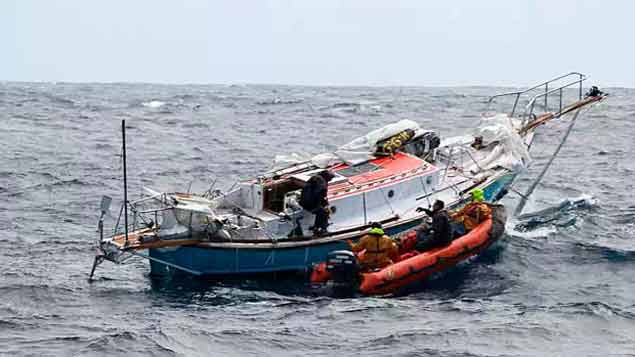 The rescue team from the Osiris alongside the dismasted Thuriya. The Indian Navy has announced that they will retrieve and restore the yacht.
The rescue team from the Osiris alongside the dismasted Thuriya. The Indian Navy has announced that they will retrieve and restore the yacht.
That India should be putting considerable government resources behind such a programme is thought-provoking for Ireland, as our private efforts in a similar direction are fragmented in the extreme, with several organisations and individuals always trying to delve into the same very limited sponsorship pool, and always doing so in the knowledge that if they do achieve support, then ultimately it will be in some foreign – and almost inevitably French – competitive event in which they have to prove themselves.
For sure, if the Atlantic Youth Trust raises the funds for its 40 m educational barquentine, that will be an Irish-based operation which will get away from the need for expensive headline-grabbing competitive sailing, while providing benefits in other directions. But the fact that the AYT’s efficient and obliging CEO Neil O’Hagan is also CEO of Team Ireland, the competitive organisation which has been supporting the racing of Enda O’Coineen, Joan Mulloy and Gregor McGuckin, gives us some idea of how thinly resources are spread.
"Team Ireland, in turn, finds itself competing with the Cork-based Ireland Ocean Racing for national support"
Team Ireland, in turn, finds itself competing with the Cork-based Ireland Ocean Racing for national support, and with the formidable talents of Nicholas “Nin” O’Leary as its star sailor and the Vendee Globe 2020 as a named possible objective, IOR has enormous potential. We can only hope that “doing good worth by stealth” is the background mantra, for it really would be like a breath of fresh air if a fully-funded campaign for any event was launched upon us completely-formed, rather than asking us to share in the exhausting twists and turns of the fund-raising process.
Either way, for would-be competitive international offshore racers starting from scratch, the route is inevitably through France, through the Mini-Transat, the Figaro Solo, the Open 40s, and the heady world of the IMOCA60s and the Vendee Globe, with all its lead-in races.
 The new foiling Figaro 3 for 2019’s Golden Jubilee of the solo spectacular is now well into production
The new foiling Figaro 3 for 2019’s Golden Jubilee of the solo spectacular is now well into production
And even if you’re French, it takes time. Sebastien Simon, who won the recent Figaro Solo, has been so consistent that he already has an IMOCA 60 for the 2020 Vendee Globe in build, but his actual first overall win in 2018 was at his fifth attempt.
The Figaro will be even more competitive and expensive next year, its Golden Jubilee, when they’ll racing the foiling Figaros 3s for the first time. But so highly-rated is it as an event that just a stage win can be greatly to your credit – Ireland’s Damian Foxall launched himself on his stellar career with that one-stage-of-Figaro win. And though Tom Dolan of Meath - who has been fighting the good fight in French sailing since 2011in the Minitransats – had very mixed results in his first Figaro this year, when everything was falling into place for his boat Smurfit Kappa he was clearly competitive, and that’s what they notice with the rookies.
 The great veteran – 73-year-old jean Luc van den Heede currently leads the Golden Globe Race by more than a thousand miles
The great veteran – 73-year-old jean Luc van den Heede currently leads the Golden Globe Race by more than a thousand miles
So if India is determined to pursue this programme of national strengthening through a developing sailing tradition, they would do well to look at France, and they probably already have many times. For we only have to reflect that the runaway leader in the Golden Globe is currently 73-year-old French deep-sea legend Jean-Luc van den Heede, who is doing it to crown out a remarkable offshore racing career, to appreciate the strength and depth of French sailing
And at the other age extreme, last November’s Minitransat was won by 20-year old Erwan le Draoulec. Until then, even the French had thought that a 20-year-old could not have developed the core stamina to win such a full-on marathon, but it seems he had.
Le Draoulec not only won, he won well. Yet afterwards – in very French style – he commented that he hadn’t really enjoyed the ferociously hard-driving day after day, as he felt that sailing across the Atlantic in this way was a sort of insult to the spirit of the great ocean……
 The philosopher-sailor who won….20 year old Erwan le Draoulec had a stunning overall win in last November’s Minitransat, but on reflection afterwards, he thought that crossing the Atlantic at maximum speed in acute discomfort was disrespectful of the ocean.
The philosopher-sailor who won….20 year old Erwan le Draoulec had a stunning overall win in last November’s Minitransat, but on reflection afterwards, he thought that crossing the Atlantic at maximum speed in acute discomfort was disrespectful of the ocean.
Any nation which, through sailing, has lifted itself from the post-war glooms to the position where its senior sailors are still winning ocean marathons while its best young sailors can be philosophizing like this after winning a great race is surely very special. But in this week of all weeks, it is Greg McGuckin who is the special one. By his gallant gesture in the full horror of the Southern Ocean, he has done Ireland proud
Gregor McGuckin's Golden Globe Yacht Not Scuttled
The Australian frigate HMAS Ballarat will be within helicopter range of Ile de Amsterdam at first light tomorrow (Thursday) and will commence operations to pick up Gregor McGuckin, one of two Golden Globe Race skippers dismasted during a fierce storm mid-way across the South Indian Ocean last Friday.
The second skipper, Indian Naval Commander Abhilash Tomy, who sustained serious back injuries when his yacht was rolled through 360° by 15m high seas, will remain in hospital until the arrival of the Indian Navy Frigate INS Satpura on Friday, when he will be transferred by helicopter for ongoing medical treatment and return to India
HMAS Ballarat will proceed back to Fremantle with McGuckin who remains in good health, arriving there on 2nd or 3rd of October.
From Commander Abhilash Tomy, reported by Indian NavyTweet: "The sea was unbelievably rough. Me & my boat Thuriya were pitched against nature's might. I survived because of my sailing skills, the soldier bit in me and my Naval training cut-in for that fight - Very thankful to Indian Navy & all who rescued me" Capt. Dilip Donde, Abhilash Tomy’s manager, reported today that Thuriya’s skipper can now stand and is eating and drinking, but requires complete rest. He will be evacuated from Ile de Amsterdam on a stretcher.
Capt. Donde also announced plans to salvage Tomy’s yacht Thuriya, left drifting in the Indian Ocean when he was recovered by the crew of the French Fisheries Patrol ship Osiris on Monday. The plan is for the Indian Navy to tow Thuriya to St Paul’s Island some 40 miles north, and leave a crew to make repairs and sail her to land.
 French Navy rescuers told McGuckin to leave his yacht afloat Photo: Australian Maritime Force
French Navy rescuers told McGuckin to leave his yacht afloat Photo: Australian Maritime Force
McGuckin’s yacht Hanley Energy Endurance was also left drifting when the Osiris crew picked him off the yacht. In a statement today, Neil O’Hagan, spokesman for Team Ireland said “During the controlled evacuation of Hanley Energy Endurance, McGuckin was instructed to leave the vessel afloat. The French fisheries patrol vessel Osiris instructed McGuckin that scuttling the vessel would be in breach of international maritime regulations. Hence, McGuckin removed all debris from the deck that could become separated, secured all equipment on board, and ensured the AIS beacon was active. The power source to the AIS device is solar panels which should remain active without any outside assistance, reducing the risk to other vessels.
Precautionary steps were also taken to ensure the relatively small amount of fuel onboard is secure.
Meanwhile, the eight remaining Golden Globe Race skippers continue to race eastwards. French leader Jean-Luc Van Den Heede sailing the Rustler 36 Matmut, passed the Cape Leeuwin longitude on Monday and is expected to arrive at the Boatshed.com film drop point off Hobart on October 3rd or 4th.
Hanley Energy, sponsor of heroic Irish sailor Gregor McGuckin, have issued the following statement on his situation.
Sponsor Hanley Energy statement:
‘’We are pleased to confirm that Gregor and Abhilash Tomy are currently safe on Ile Amsterdam. Gregor is in good health and Abhilash is being looked after by medical professionals.
We understand that Gregor’s yacht, the Hanley Energy Endurance, was dismasted in a storm while attempting to reach his fellow competitor Abhilash Tomy, who had sustained injuries after being capsized. In a remarkable display of seamanship, courage and fortitude, Gregor managed to build a jury rig and hand steer the Hanley Energy Endurance within 30 miles of Abhilash’s yacht for four days in order to be on site to assist with the rescue.Hanley Energy would like to commend Gregor on his outstanding and heroic efforts to come to the aid of his fellow competitor. He is truly an inspiration, and our priority now is to ensure his safe return to Ireland.
The Australian naval vessel HMAS Balarat is due to arrive 02.00hrs (06.00hrs local time) tomorrow (Thursday 27th September). The ship will then set a course for Perth, arriving on approximately 2nd or 3rd October. We understand that Gregor will spend time in Perth with his family before returning to Ireland.
Hanley Energy would like to thank everyone on the island, and all involved in the rescue operation for their extraordinary generosity, hospitality, and professionalism thus far.’’




























